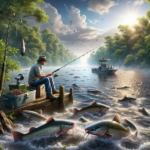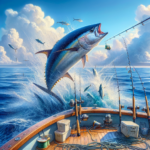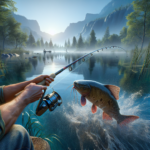Catfish Fishing in the Mississippi River: Best Spots and Techniques

Introduction
Did you know that the Mississippi River is home to some of the largest catfish in North America, with some weighing over 100 pounds? Whether you’re a seasoned angler or a novice looking to try your hand at catfishing, the Mississippi River offers a unique and rewarding experience. This article will guide you through the best spots and techniques for catfish fishing in the Mississippi River, ensuring you have all the information you need for a successful trip.
We will cover the historical and cultural significance of catfish fishing in this iconic river, provide a geographical overview, and delve into the best fishing techniques, species information, top fishing spots, and seasonal considerations. Additionally, we will offer tips and best practices, gear recommendations, safety and conservation advice, and planning tips for your trip. By the end of this article, you’ll be well-equipped to embark on your catfishing adventure in the Mississippi River.
Background/Context
Historical or Cultural Significance
Catfish fishing in the Mississippi River has a rich history that dates back to Native American tribes who relied on the river’s abundant resources for sustenance. Over the centuries, catfish have become a staple in Southern cuisine, with dishes like fried catfish and catfish stew being popular in the region. The river itself has played a crucial role in the development of the United States, serving as a major transportation route and a source of livelihood for many communities along its banks.
Geographical Overview
The Mississippi River, the second-longest river in North America, flows over 2,300 miles from its source at Lake Itasca in Minnesota to the Gulf of Mexico. The river traverses diverse landscapes, including forests, wetlands, and agricultural lands, creating a rich and varied ecosystem. The climate along the river varies from the cold winters of the northern states to the hot, humid summers of the southern states, influencing the behavior and distribution of catfish species.
Key Points/Details
Fishing Techniques
Technique Overview
Several techniques are effective for catfish fishing in the Mississippi River, including bottom fishing, drift fishing, and jug fishing. Bottom fishing involves casting baited hooks to the riverbed where catfish often feed. Drift fishing uses the river’s current to move baited lines along the bottom, covering more area. Jug fishing involves setting out floating jugs with baited lines, which can be left to drift and checked periodically.
When and Where to Use
Bottom fishing is ideal for areas with deep holes and structures where catfish like to hide. Drift fishing works well in wide, open sections of the river with a steady current. Jug fishing is best suited for slower-moving waters and backwaters where jugs can drift without getting caught in debris.
Recommended Gear
- Rods and Reels: Medium to heavy-action rods with sturdy reels capable of handling large catfish.
- Lines: Braided lines with a high pound-test rating (30-50 lbs) for strength and durability.
- Bait: Live bait such as shad, bluegill, or nightcrawlers, as well as stink baits and chicken liver.
- Hooks: Circle hooks or treble hooks in sizes 4/0 to 8/0.
- Weights: Sinker weights to keep bait on the bottom, especially in strong currents.
Species Information
Species Overview
The Mississippi River is home to several catfish species, including channel catfish, blue catfish, and flathead catfish. Channel catfish are the most common and are known for their distinctive forked tails and spotted bodies. Blue catfish are the largest, capable of reaching weights over 100 pounds, and have a bluish-gray coloration. Flathead catfish are also large and have a flat, broad head with a yellowish-brown body.
Best Practices
To successfully catch catfish, focus on areas with structures such as submerged logs, rocks, and deep holes where catfish like to hide. Use strong, durable gear to handle the size and strength of these fish. Fishing at night or during low-light conditions can increase your chances, as catfish are more active during these times. Be patient and prepared for a strong fight when you hook a catfish.
Location Information
Top Fishing Spots
- Alton Pool (Illinois/Missouri): Known for its large blue catfish, this section of the river offers excellent fishing opportunities.
- Lake Pepin (Minnesota/Wisconsin): A natural lake on the Mississippi River, Lake Pepin is a popular spot for channel catfish.
- Vicksburg (Mississippi): This area is renowned for its trophy-sized flathead catfish.
- Memphis (Tennessee): The river near Memphis is a hotspot for both blue and channel catfish.
Regulations and Licenses
Fishing regulations and license requirements vary by state along the Mississippi River. Anglers should check with the local Department of Natural Resources or Fish and Wildlife agency for specific rules, including size and bag limits, seasonal restrictions, and gear regulations. Most states require a fishing license, which can be purchased online or at local retailers.
Seasonal Considerations
Seasonal Variations
Catfish behavior and fishing conditions change throughout the year. In spring, catfish move to shallow waters to spawn, making them easier to catch. Summer offers consistent action, especially at night when catfish are more active. Fall sees catfish feeding heavily in preparation for winter, while winter fishing can be challenging but rewarding, with catfish congregating in deep holes.
Best Times to Fish
The optimal times for catfishing are during the warmer months from late spring to early fall. Night fishing is particularly effective during summer. Early morning and late evening are also productive times, as catfish are more likely to be feeding.
Events and Tournaments
Event Overview
The Mississippi River hosts several catfish fishing tournaments throughout the year, attracting anglers from across the country. Notable events include the Mississippi River Monsters tournament in Memphis and the Alton Catfish Classic in Illinois.
Preparation Tips
To prepare for a tournament, familiarize yourself with the rules and regulations, practice your fishing techniques, and ensure your gear is in top condition. Pre-fishing the tournament waters can give you an advantage by identifying productive spots. Stay hydrated and well-rested to perform your best during the event.
Tips and Best Practices
General Tips
- Scout Locations: Spend time scouting potential fishing spots before setting up.
- Use Fresh Bait: Fresh bait is more attractive to catfish and increases your chances of a bite.
- Be Patient: Catfishing requires patience, as it can take time for catfish to find your bait.
Avoid Common Mistakes
- Using Light Gear: Catfish are strong and can easily break light gear. Use heavy-duty equipment.
- Ignoring Weather Conditions: Weather can significantly impact fishing success. Pay attention to forecasts and adjust your plans accordingly.
- Overlooking Safety: Always prioritize safety, especially when fishing from a boat or in remote areas.
Advanced Techniques
- Chumming: Use chum to attract catfish to your fishing area. This can be particularly effective in slow-moving waters.
- Using Electronics: Fish finders and sonar can help locate catfish and identify underwater structures.
- Drift Fishing with Multiple Lines: Increase your chances by using multiple lines with different baits while drift fishing.
Gear and Equipment Recommendations
Essential Gear
- Medium to heavy-action rods
- Sturdy reels with a high line capacity
- Braided lines (30-50 lbs test)
- Circle hooks or treble hooks (sizes 4/0 to 8/0)
- Sinker weights
- Live bait (shad, bluegill, nightcrawlers) and stink baits
Optional Gear/Upgrades
- Fish finders and sonar equipment
- Chum dispensers
- Rod holders for boat or shore fishing
- Portable aerators for keeping live bait fresh
Where to Buy or Rent
Local bait and tackle shops along the Mississippi River offer a wide range of fishing gear and bait. Online retailers like Bass Pro Shops, Cabela’s, and Amazon also provide extensive selections. Some shops may offer rental options for larger equipment like boats and fish finders.
Safety and Conservation
Safety Tips
- Wear Life Jackets: Always wear a life jacket when fishing from a boat.
- Check Weather Conditions: Monitor weather forecasts and avoid fishing during severe weather.
- Stay Hydrated: Bring plenty of water, especially during hot weather.
- Inform Someone: Let someone know your fishing plans and expected return time.
Conservation Practices
- Catch and Release: Practice catch and release to help maintain healthy fish populations.
- Respect Wildlife: Avoid disturbing local wildlife and their habitats.
- Follow Regulations: Adhere to local fishing regulations and limits to ensure sustainable fishing.
Planning Your Trip
Accommodations
There are numerous lodging options along the Mississippi River, ranging from campgrounds and RV parks to hotels and vacation rentals. Popular areas like Memphis, Vicksburg, and Alton offer a variety of accommodations to suit different budgets and preferences.
Travel Tips
- Plan Your Route: Use GPS or maps to plan your route and identify key access points to the river.
- Check Road Conditions: Be aware of any road closures or construction that may affect your travel.
- Pack Essentials: Bring all necessary gear, food, water, and safety equipment for your trip.
Additional Activities
In addition to fishing, the Mississippi River region offers a variety of activities such as hiking, bird watching, boating, and exploring historical sites. These activities can provide a well-rounded experience for families or groups with diverse interests.
Frequently Asked Questions (FAQs)
What is the best time of year to fish for catfish in the Mississippi River?
The best time to fish for catfish is from late spring to early fall, with night fishing being particularly effective during the summer months.
Do I need a fishing license to fish in the Mississippi River?
Yes, a fishing license is required, and regulations vary by state. Check with the local Department of Natural Resources or Fish and Wildlife agency for specific requirements.
What bait is most effective for catching catfish?
Live bait such as shad, bluegill, and nightcrawlers, as well as stink baits and chicken liver, are highly effective for catching catfish.
Are there any safety concerns when fishing in the Mississippi River?
Yes, always wear a life jacket when fishing from a boat, monitor weather conditions, stay hydrated, and inform someone of your fishing plans.
Conclusion
Catfish fishing in the Mississippi River offers an exciting and rewarding experience for anglers of all skill levels. By understanding the best spots, techniques, and seasonal considerations, you can increase your chances of a successful trip. Remember to prioritize safety and conservation practices to ensure a sustainable and enjoyable fishing experience for future generations. Now that you’re equipped with all the necessary information, it’s time to grab your gear and head to the Mississippi River for an unforgettable catfishing adventure.




